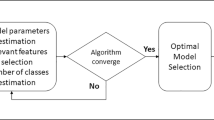Abstract
Color distribution is the most effective cue that is widely adopted in previous interactive image segmentation methods. However, it also may introduce additional errors in some situations, for example, when the foreground and background have similar colors. To address this problem, this paper proposes a novel method to learn the segmentation likelihoods. The proposed method is designed for high reliability, for which purpose it may choose to discard some unreliable likelihoods that may cause segmentation error. The reliability of likelihoods is estimated in a few Expectation–Maximization iterations. In each iteration, a novel multi-class transductive learning algorithm, namely, the Constrained Mapping, is proposed to learn likelihoods and identify unreliable likelihoods simultaneously. The resulting likelihoods then can be used as the input of any segmentation methods to improve their robustness. Experiments show that the proposed method is an effective way to improve both segmentation quality and efficiency, especially when the input image has complex color distribution.
Similar content being viewed by others
References
Bai, X., Sapiro, G.: A geodesic framework for fast interactive image and video segmentation and matting. In: Proceedings of International Conference on Computer Vision (ICCV), pp. 1–8 (2007)
Belkin, M., Niyogi, P.: Semi-supervised learning on manifolds. Mach. Learn. 56, 209–239 (2004)
Blake, A., Rother, C., Brown, M., Perez, P., Torr, P.: Interactive image segmentation using an adaptive GMMRF model. In: Proceeding of European Conference on Computer Vision (ECCV), pp. 428–441 (2004)
Boykov, Y.Y., Jolly, M.P.: Interactive graph cuts for optimal boundary & region segmentation of objects in n-d images. In: Proceedings of International Conference on Computer Vision (ICCV), pp. 105–112 (2001)
Boykov, Y., Kolmogorov, V.: An experimental comparison of min-cut/max-flow algorithms for energy minimization in vision. IEEE Trans. Pattern Anal. Mach. Intell. 26, 359–374 (2004)
Boykov, Y., Veksler, O., Zabih, R.: Efficient approximate energy minimization via graph cuts. IEEE Trans. Pattern Anal. Mach. Intell. 20(12), 1222–1239 (2001)
Criminisi, A., Sharp, T., Blake, A.: Geos: geodesic image segmentation. In: Proceeding of European Conference on Computer Vision (ECCV), pp. 99–112 (2008)
Doyle, P.G., Snell, J.L.: Random walks and electric networks. Carus Math. Monogr. 22 (1984)
Gander, W., Golub, G., Matt, U.: A constrained eigenvalue problem. Linear Algebra Appl. 815–839 (1989)
Grady, L.: Multilabel random walker image segmentation using prior models. In: Proceedings of Computer Vision and Pattern Recognition (CVPR), pp. 763–770 (2005)
Grady, L.: Random walks for image segmentation. IEEE Trans. Pattern Anal. Mach. Intell. 28(11), 1768–1783 (2006)
Gulshany, V., Rotherz, C., Criminisiz, A., Blakez, A., Zisserman, A.: Geodesic star convexity for interactive image segmentation. In: Proceedings of Computer Vision and Pattern Recognition (CVPR), pp. 3129–3136 (2010)
Joachims, T.: Transductive learning via spectral graph partitioning. In: International Conference on Machine Learning (ICML), pp. 290–297 (2003)
Kukar, M., Kononenko, I.: Reliable classifications with machine learning. In: International Conference on Machine Learning (ICML), pp. 219–231 (2002)
Ng, Y.A., Jordan, M.I., Weiss, Y.: On spectral clustering: analysis and an algorithm. In: Advances in Neural Information Processing Systems (NIPS), pp. 849–856 (2002)
Price, B.L., Morse, B., Cohen, S.: Geodesic graph cut for interactive image segmentation. In: Proceedings of Computer Vision and Pattern Recognition (CVPR), pp. 3161–3168 (2010)
Rother, C., Kolmogorov, V., Blake, A.: Grabcut Interactive foreground extraction using iterated graph cuts. In: Proceedings of ACM SIGGRAPH, pp. 309–314 (2004)
Shi, J., Malik, J.: Normalized cuts and image segmentation. IEEE Trans. Pattern Anal. Mach. Intell. 22(8), 888–905 (2000)
Sinop, A.K., Grady, L.: A seeded image segmentation framework unifying graph cuts and random walker which yields a new algorithm. In: Proceedings of International Conference on Computer Vision (ICCV), pp. 1–8 (2007)
Sun, J., Zhang, W., Tang, X., Shum, H.Y.: Background cut. In: Proceeding of European Conference on Computer Vision (ECCV), pp. 628–641 (2006)
Vicente, S., Kolmogorov, V., Rother, C.: Graph cut based image segmentation with connectivity priors. In: Proceedings of Computer Vision and Pattern Recognition (CVPR), pp. 1–8 (2008)
Viola, P., Jones, M.: Robust real-time object detection. Int. J. Comput. Vis. 57, 137–154 (2004)
Zheng, Y., Kambhamettu, C., Yu, J., Bauer, T., Steiner, K.: Fuzzymatte: a computationally efficient scheme for interactive matting. In: Proceedings of Computer Vision and Pattern Recognition (CVPR), pp. 1–8 (2008)
Author information
Authors and Affiliations
Corresponding author
Rights and permissions
About this article
Cite this article
Zhong, F., Qin, X. & Peng, Q. Robust image segmentation against complex color distribution. Vis Comput 27, 707–716 (2011). https://doi.org/10.1007/s00371-011-0588-5
Published:
Issue Date:
DOI: https://doi.org/10.1007/s00371-011-0588-5




